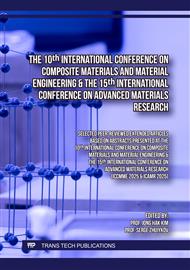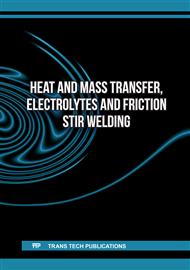[1]
K. Wu et al., 'Incombustible solid polymer electrolytes: A critical review and perspective', Journal of Energy Chemistry, vol. 93, p.264–281, Jun. 2024.
DOI: 10.1016/J.JECHEM.2024.01.013
Google Scholar
[2]
V. M. Macedo et al., 'Enhanced performance of solid polymer electrolytes combining poly(vinylidene fluoride-co-hexafluoropropylene), metal-organic framework and ionic liquid for advanced solid state lithium-ion batteries', J Energy Storage, vol. 90, p.111919, Jun. 2024.
DOI: 10.1016/J.EST.2024.111919
Google Scholar
[3]
V. Bharti, P. K. Singh, and J. P. Sharma, 'Development of polymer electrolyte membranes based on biodegradable polymer', Mater Today Proc, vol. 34, p.856–862, 2019.
DOI: 10.1016/J.MATPR.2020.06.463
Google Scholar
[4]
H. Ben Youcef, B. Orayech, J. M. L. Del Amo, F. Bonilla, D. Shanmukaraj, and M. Armand, 'Functionalized cellulose as quasi single-ion conductors in polymer electrolyte for all-solid–state Li/Na and LiS batteries', Solid State Ion, vol. 345, p.115168, Feb. 2020.
DOI: 10.1016/J.SSI.2019.115168
Google Scholar
[5]
B. H. Lim et al., 'Functionalized methyl cellulose/LiClO4 composite as an environmentally friendly quasi-solid polymer electrolyte for solid-state electrochromic devices and cellulose-based supercapacitors', Mater Today Energy, vol. 33, p.101263, Apr. 2023.
DOI: 10.1016/J.MTENER.2023.101263
Google Scholar
[6]
K. Jayalakshmi, Ismayil, S. Hegde, and J. Monteiro, 'Investigating the properties of hydroxy propyl methyl cellulose based magnesium ion-conducting solid polymer electrolytes for primary battery applications', J Energy Storage, vol. 89, p.111575, Jun. 2024.
DOI: 10.1016/J.EST.2024.111575
Google Scholar
[7]
S. A. Safavi-Mirmahalleh, S. N. Eliseeva, A. R. Moghaddam, H. Roghani-Mamaqani, and M. Salami-Kalajahi, 'Synthesis and evaluation of cellulose/polypyrrole composites as polymer electrolytes for lithium-ion battery application', Int J Biol Macromol, vol. 262, p.129861, Mar. 2024.
DOI: 10.1016/J.IJBIOMAC.2024.129861
Google Scholar
[8]
E. Quartarone and P. Mustarelli, 'Electrolytes for solid-state lithium rechargeable batteries: recent advances and perspectives', Chem Soc Rev, vol. 40, no. 5, p.2525–2540, Apr. 2011.
DOI: 10.1039/C0CS00081G
Google Scholar
[9]
Y. Xu, J. Cui, B. Guo, Z. Li, W. Wang, and W. Li, 'Cellulose-based eutectogel electrolyte with high ionic conductivity for solid-state lithium-ion batteries', Chemical Engineering Journal, vol. 491, p.151783, 2024.
DOI: 10.1016/j.cej.2024.151783
Google Scholar
[10]
X. Luan et al., 'Engineering self-healing cellulose-reinforced organohydrogel electrolytes for flexible foldable capacitors with low temperature adaptability', Ind Crops Prod, vol. 216, p.118692, Sep. 2024.
DOI: 10.1016/J.INDCROP.2024.118692
Google Scholar
[11]
Y. Huang, L. Zhang, J. Ji, C. Cai, and Y. Fu, 'Temperature-dependent viscoelastic liquid MOFs based cellulose gel electrolyte for advanced lithium-sulfur batteries over an extensive temperature range', Energy Storage Mater, vol. 64, p.103065, Jan. 2024.
DOI: 10.1016/J.ENSM.2023.103065
Google Scholar
[12]
R. Zhang, Z. Zhang, P. Xu, J. Xu, Y. Gao, and G. Gao, 'Cellulose nanofiber hydrogel with high conductivity electrolytes for high voltage flexible supercapacitors', Carbohydr Polym, vol. 326, p.121654, Feb. 2024.
DOI: 10.1016/J.CARBPOL.2023.121654
Google Scholar
[13]
X. Li, D. Xu, A. Wang, C. Peng, X. Liu, and J. Luo, 'Metal–organic cage as fluorescent probe for LiPF6 in lithium batteries', Green Energy & Environment, Jun. 2023.
DOI: 10.1016/J.GEE.2023.06.001
Google Scholar
[14]
J. zuo He et al., 'Study on synergistic effect and high temperature performance of dual-salts of LiTFSI and LiODFB in LiCoO2-based batteries', Solid State Ion, vol. 412, p.116584, Sep. 2024.
DOI: 10.1016/J.SSI.2024.116584
Google Scholar
[15]
A. Swiderska-Mocek and A. Kubis, 'Preparation and electrochemical properties of polymer electrolyte containing lithium difluoro(oxalato)borate or lithium bis(oxalate)borate for Li-ion polymer batteries', Solid State Ion, vol. 364, p.115628, Jun. 2021.
DOI: 10.1016/J.SSI.2021.115628
Google Scholar
[16]
B. S. Parimalam and B. L. Lucht, 'Reduction Reactions of Electrolyte Salts for Lithium Ion Batteries: LiPF6, LiBF4, LiDFOB, LiBOB, and LiTFSI', J Electrochem Soc, vol. 165, no. 2, pp. A251–A255, 2018.
DOI: 10.1149/2.0901802JES
Google Scholar
[17]
Y. S. Wu, C. C. Yang, S. P. Luo, Y. L. Chen, C. N. Wei, and S. J. Lue, 'PVDF-HFP/PET/PVDF-HFP composite membrane for lithium-ion power batteries', Int J Hydrogen Energy, vol. 42, no. 10, p.6862–6875, Mar. 2017.
DOI: 10.1016/J.IJHYDENE.2016.11.201
Google Scholar
[18]
S. B. Aziz et al., 'Characteristics of glycerolized chitosan: NH4 no3-based polymer electrolyte for energy storage devices with extremely high specific capacitance and energy density over 1000 cycles', Polymers (Basel), vol. 12, no. 11, p.1–23, Nov. 2020.
DOI: 10.3390/POLYM12112718
Google Scholar
[19]
M. Geng et al., 'Practical challenges and future perspectives of solid polymer electrolytes: microscopic structure and interface design', Mater Chem Front, vol. 7, no. 23, p.5963–5988, Nov. 2023.
DOI: 10.1039/D3QM00784G
Google Scholar
[20]
J. Zhang, X. Yao, R. K. Misra, Q. Cai, and Y. Zhao, 'Progress in electrolytes for beyond-lithium-ion batteries', J Mater Sci Technol, vol. 44, p.237–257, May 2020.
DOI: 10.1016/J.JMST.2020.01.017
Google Scholar



